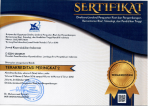DETERMINAN PENYAKIT BERBASIS LINGKUNGAN PADA ANAK BALITA DI INDONESIA
Abstract
Nowadays, many health problems are caused by unhealthy lifestyle and neighborhood conditions. This situation can be seen from a substantial contribution of environmental diseases, such as Acute Respiratory Infection (ARI) and diarrhea, to the morbidity and mortality of children under age five in Indonesia. In line with this problem, this study aimed to find out general description and determinants of environmentally based diseases in Indonesia by utilizing multinominal logistic regression method. This study used the 2013 Riset Kesehatan Dasar (Riskesdas). The result of the research showed that more than one-third of children under-five in Indonesia had suffered ARI disease and 1 of every 25 of them had suffered diarrhea. This study also found that similarities between morbidity determinants of ARI and diarrhea, such as slum dwelling, mothers education level, mother’s behavior in washing hands with soap when their hands are dirty, mother’s behavior in washing hands after they have defecated, as well as sex and age of the children under-five. Moreover, mother’s education level was the highest contributor amongst the determinants of morbidity of ARI and diarrhea in children under five. It is recommended that the government can further improve the education of women to increase women's knowledge about the healthcare environment and healthy behavior.
Keywords
Full Text:
PDFReferences
Adioetomo, S. M. & Samosir, O. B. (2010). Dasar-dasar demografi edisi 2. Jakarta: Salemba Empat.
Aldila, T. Y. (2015). Analisis faktor perilaku hidup bersih dan sehat (PHBS) dengan kejadian penyakit ISPA berulang pada balita di wilayah kerja Puskesmas Pekalongan Selatan Kota Pekalongan (Skripsi). Universitas Negeri Semarang, Semarang.
Anandari, D. (2010). Beberapa faktor yang berhubungan dengan kejadian gejala infeksi saluran pernapasan akut (ISPA) pada balita di Indonesia tahun 2007 (Skripsi). Universitas Indonesia, Depok.
Andre, Y. (2016). Penyakit berbasis lingkungan. Diakses dari https://id.scribd.com/doc/139992394/penyakit-berbasis-lingkungan
Anwar, A. & Dharmayanti, I. (2014). Pneumonia pada anak balita di Indonesia. Jurnal Kesehatan Masyarakat Nasional, 8(8), 359-365. crossref
Azen, R. & Walker, C. M. (2011). Categorical data analysis for the behavioral and social sciences. New York: Taylor & Francis Group.
Bbaale, E. (2011). Determinants of diarrhoea and acute respiratory infection among under-fives in Uganda. Australasian Medical Journal, 4(7), 400-409. crossref
Blum, H. L. (1974). Planning for health: development and application of social change theory. Michigan: Human Sciences Press.
Conant, J. & Fadem, P. (2008). A community guide to environmental health. Berkeley: Hesperian Foundation.
Cronin, A.A, Sebayang, S.K, Torlesse, H., & Nandy, R. (2016). Association of safe disposal of child feces and reported diarrhea in Indonesia: Need for stronger focus on a neglected risk. International Journal of Environmental Research and Public Health, 13(3), 310. crossref
Djaja, S., Setyowati, T., Musadad, A. & Wiryawan, Y. (2002). Kehilangan waktu potensial akibat penyakit yang berbasis lingkungan. Jurnal Ekologi Kesehatan, 1(1), 49-58.
Efendi, F. & Makhfudli. (2009). Keperawatan kesehatan komunitas: teori dan praktek dalam keperawatan. Salemba Medika: Jakarta.
Etiler, N., Velipasaoglu, S. & Aktekin, M. (2002). Incidence of acute respiratory infections and the relationship with some factors in infancy in Antalya, Turkey. Pediatrics International, 44(1), 64-69. crossref
Ghosh, S. & Bose, S. (2012). Morbidity among urban children in india distrinctions between slum and non-slum areas. Internationales Asienforum, 43(1), 47-59. Diakses dari http://crossasia-journals.ub.uni-heidelberg.de/index.php/iaf/article/viewFile/211/206#
Gupta, A., Sarker, G., Rout, A. J., Mondal, T., & Pal, R. (2015). Risk correlates of diarrhea in children under 5 years of age in slums of Bankura, West Bengal. Journal of Global Infectious, 7(1), 23-29. crossref
Hananto, M. (2004). Analisis faktor resiko yang berhubungan dengan kejadian pneumonia pada balita di 4 propinsi di Indonesia (Tesis). Universitas Indonesia, Depok.
Harianto, T. W. (2004). Faktor-faktor risiko yang berhubungan dengan kejadian diare pada bayi dan anak balita di Indonesia (Tesis). Universitas Indonesia, Depok.
Hosmer, D. W. & Lemeshow, S. (2013). Applied logistic regression (3rd edition). New York: John Willey & Sons.
Keman, S. (2005). Kesehatan perumahan dan lingkungan pemukiman. Jurnal Kesehatan Lingkungan, 2(1), 29-42. Diakses dari http://journal.unair.ac.id/download-fullpapers-KESLING-2-1-04.pdf
Kementerian Kesehatan Republik Indonesia [Kemenkes RI]. (2013). Riset kesehatan dasar 2013. Jakarta: Kemenkes RI.
________. (2013). Riset kesehatan dasar 2013 [Dataset]. Jakarta: Kemenkes RI.
________. (2015). Profil pengendalian penyakit dan penyehatan lingkungan tahun 2014. Jakarta: Kemenkes RI.
Keputusan Menteri Kesehatan [Kepmenkes] RI No.829/Menkes/SK/VII/1999 tentang Persyaratan Kesehatan Perumahan. Diakses dari http://repository.usu.ac.id/bitstream/handle/123456789/58785/Appendix.pdf?sequence=1&isAllowed=y
Komarulzaman, A., Smits, J., & de Jong, E. (2016). Clean water, sanitation and diarrhoea in Indonesia: Effects of household and community factors. Global Public Health, 1-15. crossref
Mbonye, A. K. (2004). Risk factors for diarrhoea and upper respiratory tract infections among children in a rural area of Uganda. Journal of Health, Population and Nutrition, 22(1), 52-58. Diakses dari http://www.bioline.org.br/pdf?hn04007
Mosley, W. H. & Chen, L. C. (1984). An analytical framework for the study of child survival in developing countries. Population and Development Review, 10(Suppl), 25-45. Diakses dari https://www.ncbi.nlm.nih.gov/pmc/ articles/PMC2572391/pdf/12756980.pdf
Ristiana, R. (2015). Pengaruh faktor sanitasi lingkungan, ibu, dan individu balita terhadap kejadian diare balita tahun 2013 (Skripsi). Sekolah Tinggi Ilmu Statistik, Jakarta.
Siahaan, A. H. (1991). Pengaruh genangan pasang pada lingkungan pemukiman kumuh terhadap kesehatan: studi kasus di Rw 05 Kelurahan Lagoa Kecamatan Koja Jakarta Utara (Tesis). Universitas Indonesia, Depok.
Siziya, S., Muula, A. S. & Rudatsikira, E. (2009). Diarrhoea and acute respiratory infections prevalence and risk factors among under-five children in Iraq in 2000. Italian Journal of Pediatrics, 35(8), 1-9. crossref
Susilo, R. W., Astuti, D. & Setiyadi, N. A. (2010). Faktor - faktor yang berhubungan dengan kejadian infeksi saluran pernafasan akut (ISPA) bagian atas pada balita di Desa Ngrundul Kecamatan Kebonarum Kabupaten Klaten. Jurnal Kesehatan, 4(1), 101-110. Diakses dari http://hdl.handle.net/11617/2939
United Nations Children’s Fund [UNICEF]. (2012). Water, sanitation & hygiene (Issue Briefs October 2012). Diakses dari https://www.unicef.org/indonesia/ A8_E_Issue_Brief_Water_Sanitation_REV.pdf
________. (2015). Levels & trends in child mortality report 2015. New York: UNICEF.
United Nations. (2016). Goals 3, Sustainable development knowledge platform. Diakses dari https://sustainabledevelopment.un.org/sdg3
Webber, R. (2005). Communicable disease epidemiology and control: A global perspective. Wallingford: CABI Publishing.
World Health Organization [WHO]. (2009). Global health risks: Mortality and burden of disease attributable to selected major risks. Geneva: WHO Press.
Copyright (c) 2017 Jurnal Kependudukan Indonesia

This work is licensed under a Creative Commons Attribution-NonCommercial-ShareAlike 4.0 International License.
-----------------------------------------------------------------------------------------------------------------------------
Research Center for Population, Indonesian Institute of Sciences
Widya Graha Building, 7th and 10th floors
Jl. Jenderal Gatot Subroto 10 Jakarta Selatan, Telp (021) 5221687
Website: http:/kependudukan.lipi.go.id;
E-Journal: http://ejurnal.kependudukan.lipi.go.id
Pustaka: http://pustaka.kependudukan.lipi.go.id
-----------------------------------------------------------------------------------------------------------------------------








